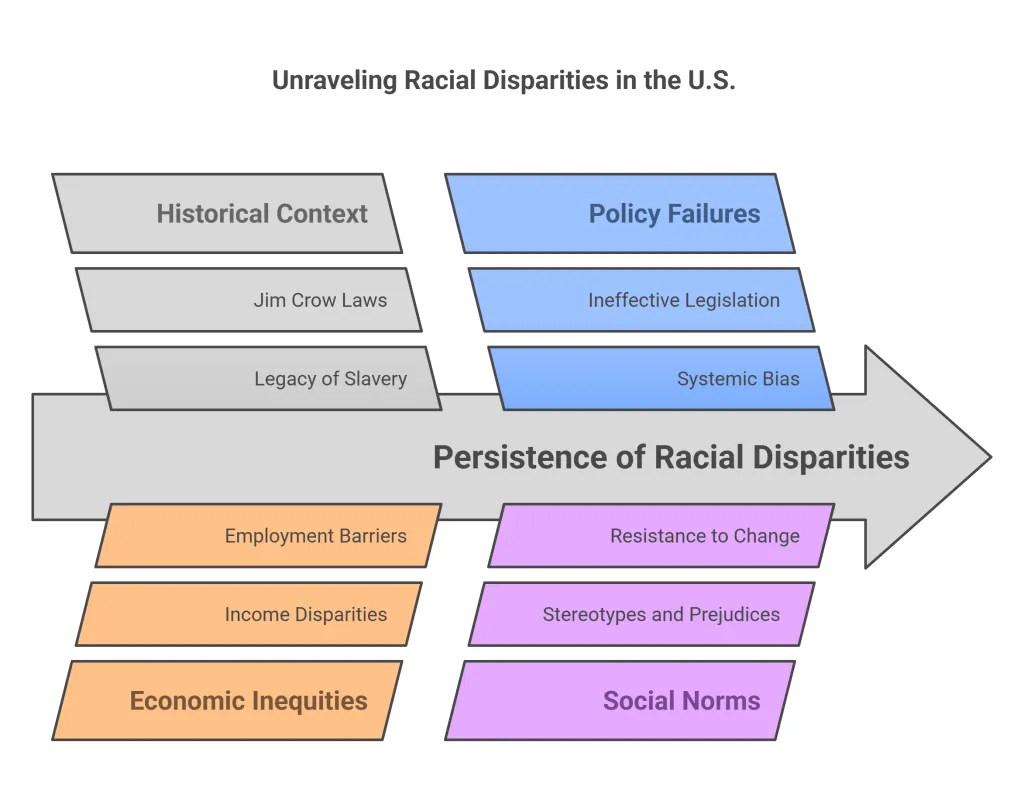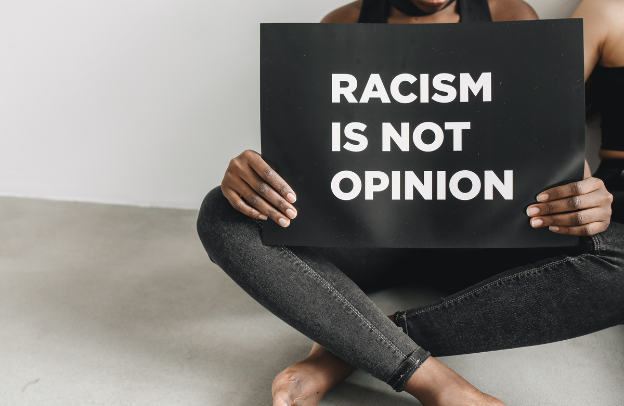The Illusion of Change: A Critical Analysis of Structural Inequities in the U.S. and the Persistence of Racial Disparities by Negus Rudison-Imhotep, Ph.D.

Dr. Negus Rudison-Imhotep | Contributor on memory and memory-building-related topics
The history of racial inequality in the United States has been marked by significant legal and social changes, particularly since the Civil Rights Movement. Landmark legislation, such as the Civil Rights Act of 1964 and the Voting Rights Act of 1965, was intended to address systemic racial discrimination and promote equality for African Americans.
Learn with AClasses Media and improve yourself and your business skills.
However, critical scholars like Dr. Derrick Bell argue that while legal reforms have occurred, the deeper structures of racial inequality have largely remained intact. Bell’s concept of interest convergence suggests that racial justice improvements are often made only when they align with the interests of the dominant (white) group.

This essay explores Bell’s argument using empirical data to show how institutional practices, policies, and laws continue to perpetuate racial inequalities in the U.S.
Despite legislative progress, the persistence of racial disparities in areas such as housing, wealth accumulation, education, and policing points to the fundamental truth that the underlying structures of inequality remain unchanged.
The Illusion of Change: Structural Inequities and Racial Disparities
Despite the passage of key civil rights legislation, the structures that perpetuate racial inequities remain deeply embedded in American society.
Dr. Derrick Bell’s critical race theory challenges the idea of linear progress by showing how laws and policies, while seemingly progressive, often fail to disrupt the underlying power dynamics that marginalize African Americans and other people of color.
Housing Policies and Redlining: A Legacy of Disadvantage
One of the clearest examples of how structural inequalities have persisted is in housing. Redlining, a practice that began in the 1930s, involved systematically denying mortgage loans to residents of predominantly Black neighborhoods, marking them as “high-risk” areas.
This practice, codified by federal housing policies and supported by private banks, restricted Black families from accessing homeownership and, by extension, wealth-building opportunities.
See also Can A Felon Get a Break? by Negus Rudison-Imhotep, Ph.D.
Even though redlining was formally outlawed with the passage of the Fair Housing Act of 1968, its effects are still evident today. According to a 2020 report from the National Community Reinvestment Coalition (NCRC), neighborhoods that were once subjected to redlining continue to experience lower homeownership rates, lower property values, and fewer investments.
These areas have also experienced higher levels of poverty and unemployment, reinforcing the intergenerational cycle of economic disadvantage for African American families.
The Federal Reserve’s 2019 report on wealth inequality found that the median net worth of Black families is just $24,100, compared to $189,100 for white families, a gap largely driven by disparities in homeownership.
This persistence of racial inequality in housing illustrates Bell’s point that while surface-level progress has been made, the deeper structures that enforce racial disadvantage remain largely intact.
As Bell argued, true structural change requires more than just legislation; it requires the dismantling of the underlying systems that perpetuate inequality.
Racial Wealth Gap: Persistent Economic Inequality
Another glaring example of the persistence of racial inequality is the wealth gap between Black and white Americans.
Despite efforts to reduce racial disparities through policies like affirmative action and welfare programs, the wealth gap remains stark. According to a 2020 report from the Brookings Institution, Black families are significantly less likely to own assets such as stocks, bonds, or retirement accounts, compared to white families.
While the median wealth of Black families has slightly increased over the past few decades, the gap between Black and white wealth has remained wide and has even widened in recent years due to factors such as the 2008 housing crisis, which disproportionately affected Black homeowners.
The 2020 report from the Institute for Policy Studies highlights how Black Americans’ wealth is constrained by historical discrimination, including slavery, segregation, and discriminatory lending practices.
Although the U.S. economy has grown substantially since the Civil Rights Movement, the policies that would address the legacy of this economic exclusion, such as reparations or broad wealth redistribution, have not been fully implemented.
See also Civil Society Forum Address
This enduring economic disparity underscores Bell’s argument that real progress is constrained by the interests of the dominant group, which continues to benefit from the existing power structures.
Discriminatory Practices in Education: A Systemic Problem
The American education system also reflects the deep-rooted racial inequities Bell critiques. While Brown v. Board of Education (1954) declared racial segregation in public schools unconstitutional, many schools remain racially segregated to this day due to housing patterns and funding mechanisms that tie educational resources to local property taxes.
This segregation results in significant disparities in the quality of education provided to Black and white students.
Research by the U.S. Department of Education and the Civil Rights Data Collection (CRDC) consistently shows that Black students are more likely to attend schools with fewer resources, higher teacher turnover, and more discipline-related issues compared to their white peers.
A 2016 study published in Educational Researcher found that schools with higher concentrations of Black students are more likely to have inexperienced teachers and fewer advanced placement courses. Additionally, Black students are disproportionately disciplined, facing higher rates of suspension and expulsion.
These educational disparities contribute to long-term consequences, such as lower college graduation rates and poorer employment outcomes for Black Americans.
Bell’s assertion that racial progress is often illusory is evident in these ongoing disparities. While the legal framework has changed, the structures that ensure unequal educational outcomes for Black students have not been fundamentally challenged.
Disproportionate Police Violence: The Enduring Legacy of Racial Injustice
One of the most visible and alarming manifestations of structural racial inequality is police violence against Black Americans. The brutalization of Black communities by law enforcement is a direct consequence of longstanding racist policies and practices.
Despite the Civil Rights Movement’s efforts to curb discriminatory law enforcement practices, data shows that Black Americans are disproportionately affected by police violence.
According to a 2020 study by the Proceedings of the National Academy of Sciences, Black Americans are 2.5 times more likely to be killed by police officers than white Americans.
This disparity is not just a matter of individual actions by law enforcement officers but is tied to broader structural issues within policing, such as racial profiling, the over-policing of Black neighborhoods, and the militarization of police forces.
The lack of accountability for police officers who engage in violent acts against Black individuals, as seen in high-profile cases like the deaths of George Floyd, Breonna Taylor, Eric Garner, and Frank Tyson, underscores the persistence of systemic racism in the criminal justice system.
These patterns of racial violence reveal that, despite the legal reforms of the past, the underlying structures that allow for such violence continue to operate unchecked. Bell’s critique of the limited nature of racial progress in America holds in the case of policing, where true reform remains elusive.
Conclusion on A Critical Analysis of Structural Inequities in the U.S. and the Persistence of Racial Disparities
The continued existence of racial inequality in housing, wealth, education, and policing challenges the notion that the United States has made meaningful progress toward racial equality. Dr. Derrick Bell’s critique of the illusion of change highlights how the deeper structures of racial discrimination remain embedded in American society.
Empirical evidence from various domains—housing policies, the racial wealth gap, educational inequality, and police violence—demonstrates that the legal victories of the Civil Rights Movement have not dismantled the foundational systems that perpetuate inequality.
While the U.S. has maintained global stability and power, domestically, the social order remains unchanged for marginalized communities. Bell’s work urges us to confront these inequities’ persistence and challenge the power structures that sustain them. Only through genuine efforts to dismantle these systems can true progress be made.
Learn with AClasses Media and improve yourself and your business skills.
References
- Bell, Derrick A.
- Bell, D. A. (1980). Race, Racism, and American Law (3rd ed.). Boston: Little, Brown, and Company.
- Bell’s foundational works on Critical Race Theory and the interest convergence theory, which help inform the argument on the persistence of racial inequality.
- National Community Reinvestment Coalition (NCRC).
- National Community Reinvestment Coalition. (2020). The Case for Reparations: Redlining’s Legacy and Black Wealth. Retrieved from https://ncrc.org
- This report discusses the long-term effects of redlining, including its impact on African American homeownership and wealth accumulation.
- Federal Reserve Board.
- Federal Reserve. (2019). Disparities in Wealth by Race and Ethnicity in the 2019 Survey of Consumer Finances. Federal Reserve Bulletin, 105(4).
- A study from the Federal Reserve providing evidence on the racial wealth gap and how systemic factors contribute to wealth disparities between Black and white Americans.
- Institute for Policy Studies.
- Williams, R., & Weiner, J. (2020). The Road to Repair: The Case for Reparations in America. Institute for Policy Studies.
- This report provides data on the racial wealth gap and the impact of historical discrimination on economic inequality.
- U.S. Department of Education, Civil Rights Data Collection (CRDC).
- U.S. Department of Education. (2016). Civil Rights Data Collection: Data Snapshot (School Discipline). Retrieved from https://ocrdata.ed.gov
- This source provides data on racial disparities in school discipline and educational resources, which support the argument about persistent inequalities in education.
- Proceedings of the National Academy of Sciences (PNAS).
- Edwards, F., Lee, H., & Esposito, M. (2020). Risk of Being Killed by Police Use of Force in the United States by Age, Race–Ethnicity, and Sex. Proceedings of the National Academy of Sciences, 117(36), 22343-22351.
- This study provides empirical evidence of racial disparities in police violence, specifically highlighting the disproportionate risk faced by Black Americans.
- Economic Policy Institute (EPI).
- Bivens, J., & Zipperer, B. (2020). How Race and Class Shape Economic Inequality in the U.S. Economic Policy Institute.
- A report that examines the relationship between race and economic inequality, including issues like wage disparities and economic mobility.
- Brookings Institution.
- Morsy, L., & Rothstein, R. (2020). The Racial Wealth Gap: Why It Persists and What We Can Do About It. Brookings Institution.
- This study focuses on the structural causes of the racial wealth gap, offering insights into the enduring economic disparities between Black and white Americans.
- U.S. Department of Housing and Urban Development (HUD).
- U.S. Department of Housing and Urban Development. (2019). The Impact of the Fair Housing Act on Housing Markets.
- A government report detailing the history and ongoing effects of housing discrimination practices like redlining and their impact on Black Americans’ ability to accumulate wealth.
- Educational Researcher.
- Lauen, D. L., & Gaddis, M. S. (2016). School Composition and Educational Inequality: The Effect of Racial Segregation on Educational Outcomes. Educational Researcher, 45(3), 191-200.
- This article examines how racial segregation in schools continues to affect educational outcomes, reinforcing systemic disparities in access to resources.






